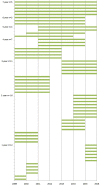Surveillance of infections in long-term care facilities (LTCFs): The impact of participation during multiple years on health care-associated infection incidence
- PMID: 31496454
- PMCID: PMC6805744
- DOI: 10.1017/S0950268819001328
Surveillance of infections in long-term care facilities (LTCFs): The impact of participation during multiple years on health care-associated infection incidence
Abstract
We studied trends in the incidence of health care-associated infections (HAIs) in LTCFs between 2009 and 2015 and determined the effect of participation in our network. Elder-care physicians reported weekly the number of cases of influenza-like illness, gastroenteritis, (probable) pneumonia, urinary tract infections (UTIs) and all-cause mortality. Trends in the incidence of infection and mortality in relation to LTCF characteristics were calculated using multilevel univariate and multivariate logistic regression. Thirty LTCF participated for 3 years or more, 16 for 2 years and the remaining 12 LTCF for 1 year. During the study period, the median number of beds decreased from 158 to 139, whereas the percentage of residents with private bedrooms increased from 14% to 87%. UTIs were the most frequently reported infections, followed by (probable) pneumonia and gastroenteritis. Adjusted for calendar year and season, we observed a statistically significant decrease in the incidence of influenza-like illness (odds ratio (OR) = 0.8, P < 0.01) and (probable) pneumonia (OR = 0.8, P < 0.01) for each extra year an LTCF participated. Although there are other likely contributors, such as more private rooms and enhanced infection control measures, the decreasing trend of HAI in LTCFs participating in surveillance implies that surveillance is a valuable addition to current strategies to optimise infection control.
Keywords: Incidence; infectious disease epidemiology; surveillance system.
Conflict of interest statement
None.
Figures
References
-
- Castle SC (2000) Clinical relevance of age-related immune dysfunction. Clinical Infectious Diseases 31, 578–585. - PubMed
-
- Gavazzi G and Krause KH (2002) Ageing and infection. Lancet Infectious Diseases 2, 659–666. - PubMed
-
- Strausbaugh LJ and Joseph CL (2000) The burden of infection in long-term care. Infection Control & Hospital Epidemiology 21, 674–679. - PubMed
-
- Koch AM et al. (2009) Severe consequences of healthcare-associated infections among residents of nursing homes: a cohort study. Journal of Hospital Infection 71, 269–274. - PubMed
Publication types
MeSH terms
LinkOut - more resources
Full Text Sources



